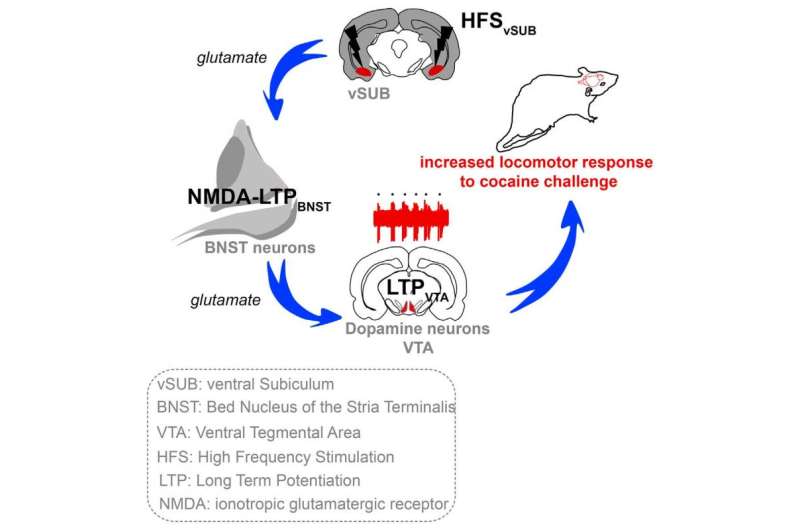New insights on how cocaine changes the brain

The burst of energy and hyperactivity that comes with a cocaine high is a rather accurate reflection of what's going on in the brain of its users, finds a study published November 25 in Cell Reports. Through experiments conducted in rats exposed to cocaine, the researchers mapped out the network of circuits that cause wild firing of neurons that produce dopamine, a neurotransmitter that regulates movement and emotion. The findings also help explain how cocaine use eventually leads to desensitization.
The researchers used tracer molecules to follow electrical activity in the brain in rats exposed to cocaine. They found that a hub of neurons in the extended amygdala (the brain's motivation/learning center) acts as a relay between activation of the ventral subiculum (the brain's addiction center) and the hyperactive release of dopamine.
Over time, increasing activation of a key part of the extended amygdala—the bed nucleus of the stria terminalis produces a long-lasting increase in signal transmission onto neurons that produce dopamine so that the rats became desensitized to the cocaine. Since this change happens within the amygdala, it may explain some of the long-term effects on behavior and motivation that occur after prolonged cocaine use.
"Unraveling the neuronal circuit and characterizing the synaptic mechanisms by which the ventral subiculum alters the excitability of dopamine neurons is a necessary first step in understanding the resulting behavioral changes induced by cocaine," says senior author François Georges of Bordeaux University in France. "We show that the ventral subiculum recruits the bed nucleus of the stria terminalis to drive a persistent hyperactivity of dopamine neurons and control cocaine-induced activity."
Surprisingly, a single stimulation of the ventral subiculum (which lasts about 10 minutes in an anesthetized rat) had the same impact on the brain and dopamine neurons as a massive injection of cocaine. These effects lasted up to five days and raise the possibility that dopamine-producing neurons can be changed so that they respond differently to stimuli.

In addition to providing insights on the circuits involved in drug addiction, the findings might be helpful for understanding and even changing the perception of natural rewards; for example, those related to food or exercise, which the authors plan to pursue next.
More information: Cell Reports, Glangetas and Fois et al.: "Ventral Subiculum Stimulation Promotes Persistent Hyperactivity of Dopamine Neurons and Facilitates Behavioral Effects of Cocaine" dx.doi.org/10.1016/j.celrep.2015.10.076














